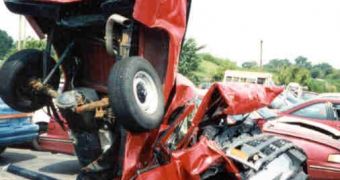It's less dangerous walking through the jungle than driving a car in a big city. The city traffic clearly produces much more victims. A new study could improve the state of victims of the most severe spinal injuries caused by car crashes.
A collaboration between the University of Leeds and Queen's University Belfast is working in the development of biological cements for fixing 'burst fractures' of the spine. Bone cements, resembling those employed in joint replacement surgery, are already applied for strengthening harmed vertebrae in cases of osteoporosis, through a procedure called vertebroplasty, but the spine's 'burst fractures', induced by major impact crashes and falls, pose much more difficulties.
They rise to over 1,000 emergency NHS admissions annually and usually they mean highly complex, invasive surgery and a long recovery time. "This type of fracture causes the vertebra to burst apart and in severe cases fragments of bone can be pushed into the spinal cord. Surgeons may be able to join bone fragments together and stabilize the spine with the use of metal screws and rods, but patients with these injuries are often in a really bad way, so the less invasive the treatment, the better," said Dr Ruth Wilcox of Leeds' Institute of Medical and Biological Engineering.
Queen's team has a long experience on synthetic biomaterials for fixing bone abnormalities. "These materials can be delivered to the fracture site by injection and mimic the chemical composition of bone itself," said Dr Fraser Buchanan, from the University's School of Mechanical and Aerospace Engineering.
The Leeds team has the knowledge in spine's computational modeling, providing the Queen team with the required information for developing new biomaterials and to make computer simulations of their performance in living bodies.
Most burst fractures occur in younger people, and the long-term effects of the current cements employed for treating them is not known. Some older patients with osteoporosis can experience fractures in the vertebrae neighboring the "treated" ones. "We think this may be because current cements are stiffer than the bone itself causing an imbalance in the way the spine bears weight. This may increase loading on the neighboring vertebrae, which can lead to further damage", said Wilcox.
"Clearly we need to develop biomaterials that more closely match the properties of real bone. This project offers the perfect opportunity to use the range of complimentary skills of this grouping to predict the effects of newly developed cements and even incorporate biological agents to assist the body's own healing process," added Buchanan.
Simpler, more rapid and much less invasive techniques would decrease both recovery times and NHS costs.

 14 DAY TRIAL //
14 DAY TRIAL //